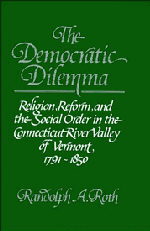 The Democratic Dilemma
The Democratic Dilemma Book contents
- Frontmatter
- Contents
- List of tables and maps
- Acknowledgments
- Introduction
- 1 The revolutionary frontier, 1763–1800
- 2 The failure of the covenanted community and the standing order, 1791–1815
- 3 Religion and reform in the shaping of a new order, 1815–1828
- 4 From an era of promise to pressing times, 1815–1843
- 5 A clamor for reform, 1828–1835
- 6 The great revival, 1827–1843
- 7 A modified order in town life and politics, 1835–1850
- 8 Boosterism, sentiment, free soil, and the preservation of a Christian, reformed republic
- Conclusion: Religion, reform, and the problem of order in the Age of Democratic Revolution
- Appendix A Church records
- Appendix B Types of towns
- Appendix C Occupational groups
- Appendix D Statistical methods
- Notes
- Index
Appendix D - Statistical methods
Published online by Cambridge University Press: 04 August 2010
- Frontmatter
- Contents
- List of tables and maps
- Acknowledgments
- Introduction
- 1 The revolutionary frontier, 1763–1800
- 2 The failure of the covenanted community and the standing order, 1791–1815
- 3 Religion and reform in the shaping of a new order, 1815–1828
- 4 From an era of promise to pressing times, 1815–1843
- 5 A clamor for reform, 1828–1835
- 6 The great revival, 1827–1843
- 7 A modified order in town life and politics, 1835–1850
- 8 Boosterism, sentiment, free soil, and the preservation of a Christian, reformed republic
- Conclusion: Religion, reform, and the problem of order in the Age of Democratic Revolution
- Appendix A Church records
- Appendix B Types of towns
- Appendix C Occupational groups
- Appendix D Statistical methods
- Notes
- Index
Summary
Statistical methods
The analysis of the behavior of individuals in the nine towns studied intensively rests on tabulation. Significance tests are not reported for the various tables in the text. The data reported in these tables are complete rather than sampled from a larger body of data, so such tests are not directly meaningful. Each table was computed for each town separately, however, to ensure that the trends observed in the composite tables are not artifacts of compilation, but are visible in each town. Exceptions to trends are reported in the text. Not every trend in the tables is strong, nor does every table include a substantial number of cases, which makes interpretation difficult. These cases are also treated in some detail in the text.
Inadequate data pose several problems. The lack of tax lists from Woodstock and Ryegate makes it impossible to determine the proportion of the adult male population that belonged to a particular church or pursued a particular occupation in a given year. The tables on reformers and political activists, which include data from Woodstock and Ryegate, therefore describe the proportion of the members of each political or reform movement who belonged to a particular church or pursued a particular occupation, rather than vice versa. These tables compare the members of each movement with the members of other movements, but do not reveal how representative the members of each movement were of the entire population of the towns studied intensively.
- Type
- Chapter
- Information
- The Democratic DilemmaReligion, Reform, and the Social Order in the Connecticut River Valley of Vermont, 1791–1850, pp. 323 - 324Publisher: Cambridge University PressPrint publication year: 1987


